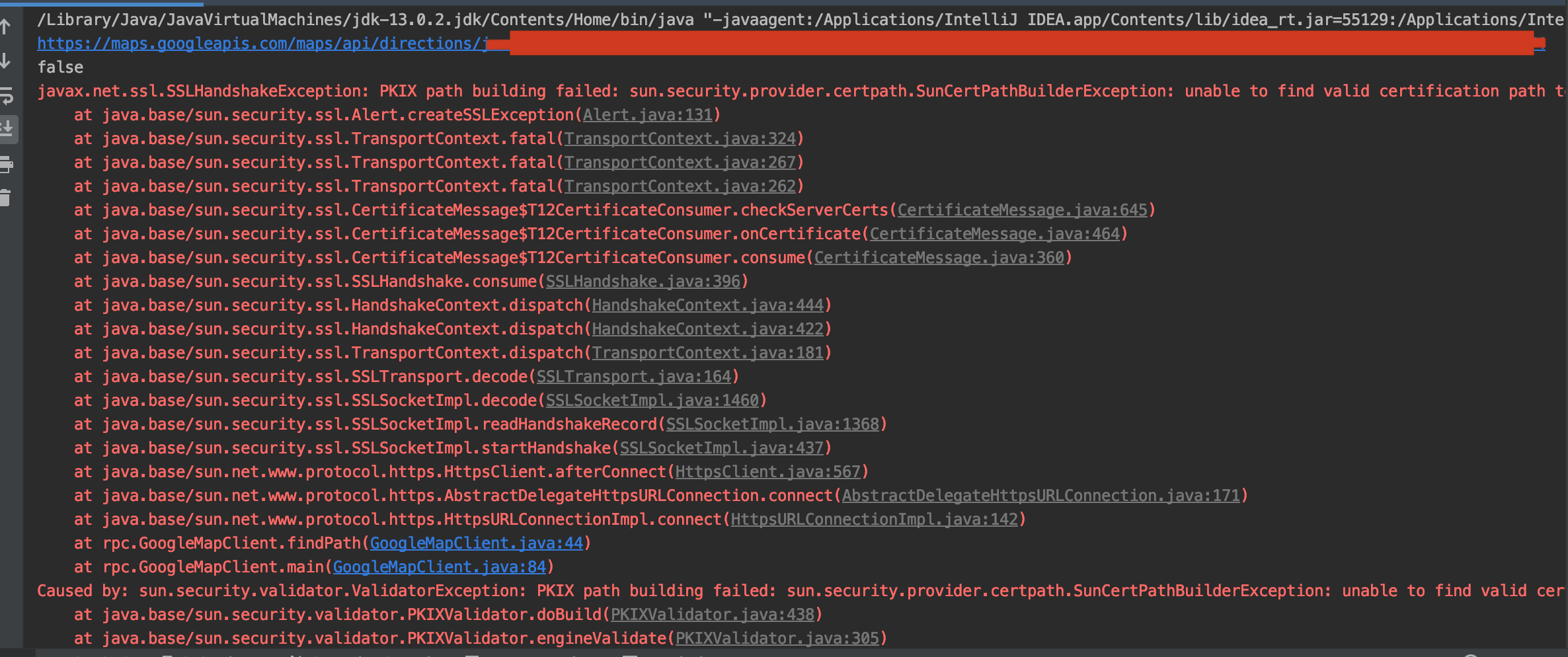I have a class that will download a file from a https server. When I run it, it returns a lot of errors. It seems that I have a problem with my certificate. Is it possible to ignore the client-server authentication? If so, how?
package com.da;
import java.io.FileOutputStream;
import java.io.IOException;
import java.nio.CharBuffer;
import java.util.concurrent.Future;
import org.apache.http.HttpResponse;
import org.apache.http.client.utils.URIUtils;
import org.apache.http.impl.nio.client.DefaultHttpAsyncClient;
import org.apache.http.nio.IOControl;
import org.apache.http.nio.client.HttpAsyncClient;
import org.apache.http.nio.client.methods.AsyncCharConsumer;
import org.apache.http.nio.client.methods.HttpAsyncGet;
import org.apache.http.nio.client.methods.HttpAsyncPost;
public class RSDDownloadFile {
static FileOutputStream fos;
public void DownloadFile(String URI, String Request) throws Exception
{
java.net.URI uri = URIUtils.createURI("https", "176.66.3.69:6443", -1, "download.aspx",
"Lang=EN&AuthToken=package", null);
System.out.println("URI Query: " + uri.toString());
HttpAsyncClient httpclient = new DefaultHttpAsyncClient();
httpclient.start();
try {
Future<Boolean> future = httpclient.execute(
new HttpAsyncGet(uri),
new ResponseCallback(), null);
Boolean result = future.get();
if (result != null && result.booleanValue()) {
System.out.println("\nRequest successfully executed");
} else {
System.out.println("Request failed");
}
}
catch(Exception e){
System.out.println("[DownloadFile] Exception: " + e.getMessage());
}
finally {
System.out.println("Shutting down");
httpclient.shutdown();
}
System.out.println("Done");
}
static class ResponseCallback extends AsyncCharConsumer<Boolean> {
@Override
protected void onResponseReceived(final HttpResponse response) {
System.out.println("Response: " + response.getStatusLine());
System.out.println("Header: " + response.toString());
try {
//if(response.getStatusLine().getStatusCode()==200)
fos = new FileOutputStream( "Response.html" );
}catch(Exception e){
System.out.println("[onResponseReceived] Exception: " + e.getMessage());
}
}
@Override
protected void onCharReceived(final CharBuffer buf, final IOControl ioctrl) throws IOException {
try
{
while (buf.hasRemaining())
{
//System.out.print(buf.get());
fos.write(buf.get());
}
}catch(Exception e)
{
System.out.println("[onCharReceived] Exception: " + e.getMessage());
}
}
@Override
protected void onCleanup() {
try
{
if(fos!=null)
fos.close();
}catch(Exception e){
System.out.println("[onCleanup] Exception: " + e.getMessage());
}
System.out.println("onCleanup()");
}
@Override
protected Boolean buildResult() {
return Boolean.TRUE;
}
}
}
Errors:
URI Query: https://176.66.3.69:6443/download.aspx?Lang=EN&AuthToken=package
Aug 2, 2011 3:47:57 PM org.apache.http.impl.nio.client.NHttpClientProtocolHandler exception
SEVERE: I/O error: General SSLEngine problem
javax.net.ssl.SSLHandshakeException: General SSLEngine problem
at com.sun.net.ssl.internal.ssl.Handshaker.checkThrown(Unknown Source)
at com.sun.net.ssl.internal.ssl.SSLEngineImpl.checkTaskThrown(Unknown Source)
at com.sun.net.ssl.internal.ssl.SSLEngineImpl.writeAppRecord(Unknown Source)
at com.sun.net.ssl.internal.ssl.SSLEngineImpl.wrap(Unknown Source)
at javax.net.ssl.SSLEngine.wrap(Unknown Source)
at org.apache.http.impl.nio.reactor.SSLIOSession.doHandshake(SSLIOSession.java:154)
at org.apache.http.impl.nio.reactor.SSLIOSession.isAppInputReady(SSLIOSession.java:276)
at org.apache.http.impl.nio.client.InternalClientEventDispatch.inputReady(InternalClientEventDispatch.java:79)
at org.apache.http.impl.nio.reactor.BaseIOReactor.readable(BaseIOReactor.java:161)
at org.apache.http.impl.nio.reactor.AbstractIOReactor.processEvent(AbstractIOReactor.java:335)
at org.apache.http.impl.nio.reactor.AbstractIOReactor.processEvents(AbstractIOReactor.java:315)
at org.apache.http.impl.nio.reactor.AbstractIOReactor.execute(AbstractIOReactor.java:275)
at org.apache.http.impl.nio.reactor.BaseIOReactor.execute(BaseIOReactor.java:104)
at org.apache.http.impl.nio.reactor.AbstractMultiworkerIOReactor$Worker.run(AbstractMultiworkerIOReactor.java:542)
at java.lang.Thread.run(Unknown Source)
Caused by: javax.net.ssl.SSLHandshakeException: General SSLEngine problem
at com.sun.net.ssl.internal.ssl.Alerts.getSSLException(Unknown Source)
at com.sun.net.ssl.internal.ssl.SSLEngineImpl.fatal(Unknown Source)
at com.sun.net.ssl.internal.ssl.Handshaker.fatalSE(Unknown Source)
at com.sun.net.ssl.internal.ssl.Handshaker.fatalSE(Unknown Source)
at com.sun.net.ssl.internal.ssl.ClientHandshaker.serverCertificate(Unknown Source)
at com.sun.net.ssl.internal.ssl.ClientHandshaker.processMessage(Unknown Source)
at com.sun.net.ssl.internal.ssl.Handshaker.processLoop(Unknown Source)
at com.sun.net.ssl.internal.ssl.Handshaker$1.run(Unknown Source)
at java.security.AccessController.doPrivileged(Native Method)
at com.sun.net.ssl.internal.ssl.Handshaker$DelegatedTask.run(Unknown Source)
at org.apache.http.impl.nio.reactor.SSLIOSession.doHandshake(SSLIOSession.java:180)
... 9 more
Caused by: sun.security.validator.ValidatorException: PKIX path building failed: sun.security.provider.certpath.SunCertPathBuilderException: unable to find valid certification path to requested target
at sun.security.validator.PKIXValidator.doBuild(Unknown Source)
at sun.security.validator.PKIXValidator.engineValidate(Unknown Source)
at sun.security.validator.Validator.validate(Unknown Source)
at com.sun.net.ssl.internal.ssl.X509TrustManagerImpl.checkServerTrusted(Unknown Source)
at com.sun.net.ssl.internal.ssl.JsseX509TrustManager.checkServerTrusted(Unknown Source)
... 16 more
Caused by: sun.security.provider.certpath.SunCertPathBuilderException: unable to find valid certification path to requested target
at sun.security.provider.certpath.SunCertPathBuilder.engineBuild(Unknown Source)
at java.security.cert.CertPathBuilder.build(Unknown Source)
... 21 more
onCleanup()
[DownloadFile] Exception: javax.net.ssl.SSLHandshakeException: General SSLEngine problem
Shutting down
Done


